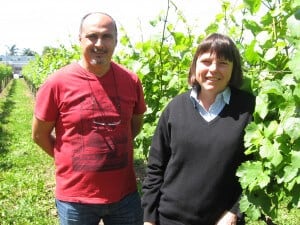 An associate professor of viticulture from a country with one of the world’s longest records of winemaking, Dr Elman Bahar recently worked with EIT scientists on several major industry research projects.
An associate professor of viticulture from a country with one of the world’s longest records of winemaking, Dr Elman Bahar recently worked with EIT scientists on several major industry research projects.
From Namik Kemal University in Turkey, Dr Bahar primarily worked with EIT researchers on a study aimed at establishing whether the use of an anti-transpirant spray may be a viable alternative to removing foliage on grapevines – a practice aimed at achieving optimum berry ripeness and wine quality.
Dr Bahar is the first international researcher to be based at EIT on sabbatical. During his three-month stint, he worked with School of Viticulture and Wine Science researchers Dr Petra King and Associate Professor Carmo Saunders-Vasconcelos.
As the growing season got underway, the research team mainly focused on setting up the second year of the study, which is being extended to include Sauvignon Blanc as well as Merlot. Dr Bahar also assisted in developing and training members of EIT’s wine sensory panel, a project established by Dr Vasconcelos.
Dr Bahar has maintained contact with EIT since meeting an international marketing team in Turkey five years ago. Having read about New Zealand’s wine industry in specialist publications, he was interested in seeing it for himself.
While his experience was largely limited to Hawke’s Bay, he says the two countries are very different in terms of their viticulture.
Turkey, he says has a hot climate and the industry encompasses traditional and new methods for making wine.
“New Zealand has cool climate conditions and attracts a lot of rain. You don’t have the same diseases we have in Turkey. Your wines are completely different – they are more aromatic and fruity and floral. In Turkey the wines are more tannic.”
Turkey was among the first countries in the world to domesticate the wild Eurasian grapevine and wine is believed to have been made there for at least 7000 years. It is the world’s fifth biggest grape growing region, harvesting more than four million tonnes of fruit a year.
Most of the production, however, is for table grapes and raisins. Turkey produces less wine than New Zealand and only a small proportion of that is destined for export. It is ranked 35th in the world for wine production and New Zealand 18th.
By comparison, however, New Zealand is ranked 37th in the world for its vineyard area.
Turkey grows classical French varieties such as Cabernet Sauvignon, Syrah, Merlot, Cabernet Franc and Malbec and also some Italian and German varieties. However, 1400 local varieties provide irreplaceable genetic diversity. Many of these varieties are grown for making wine, largely for local consumption.
As a variety, Kalecik karasi may be more than 1000 years old. Other reds include Papazkarasi, Bagazkere, Horoz Karasi and Karalahna. The best red local red, says Dr Bahar, is Okuzgoyzu, a very tannic and aromatic wine. Whites include Beylerce, Hasandede, Narince and Emir.
Throughout Turkey, most vines are grown in the traditional bush form and are not trellised.
The area in vineyard decreased from 517,000 acres in 2012 to 468,000 acres last year as vines made way for olive and fruit trees. But while there was a 20 percent decrease in the vineyard area between 1988 and 2013, there was a 20 percent increase in yield.
Some 27,000 students attend Namik Kemal University in Tekirdag province on the European side of Turkey. Dr Bahar supervises students working on master’s and doctorate degrees in viticulture.
